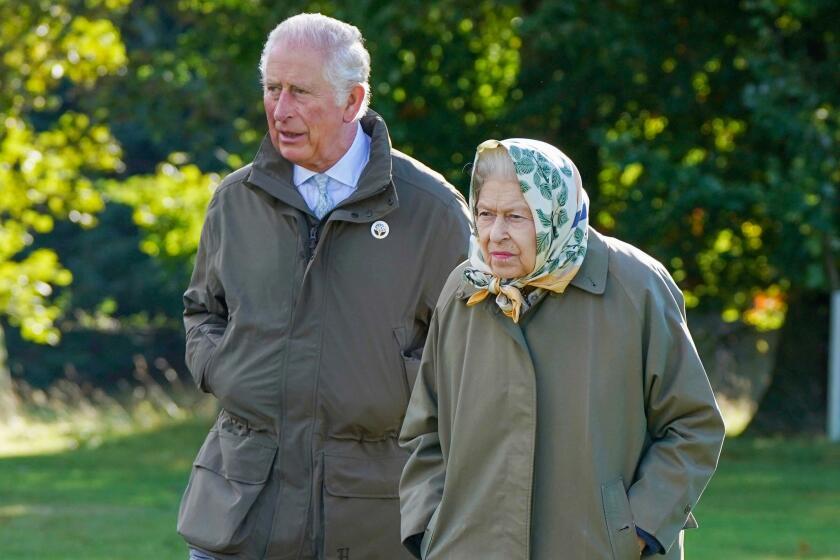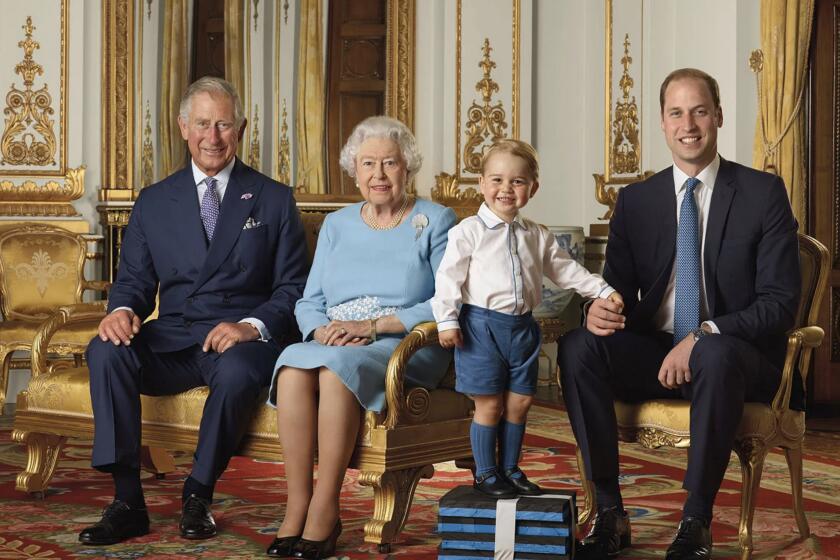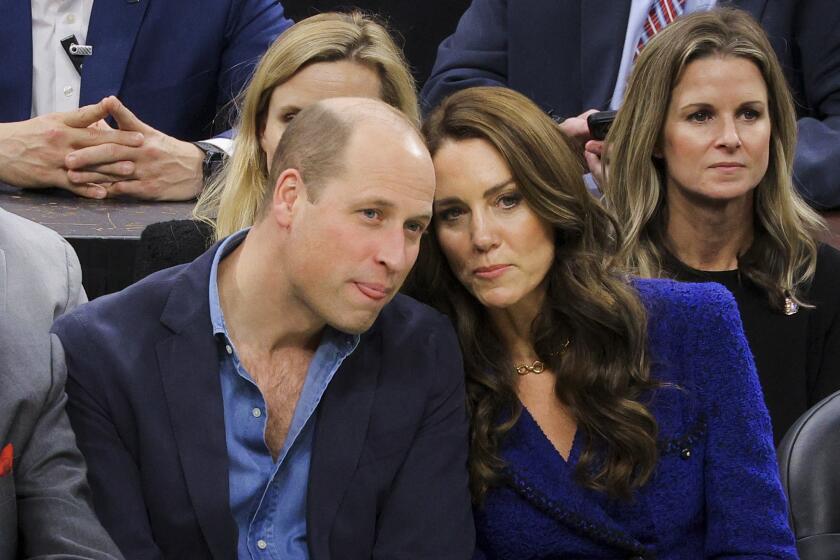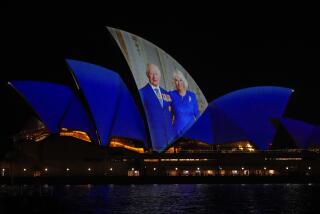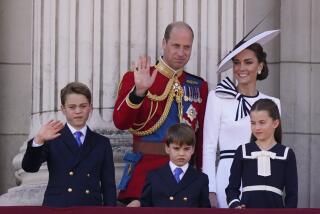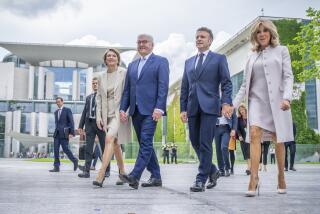King Charles III makes his international debut with a trip to Germany
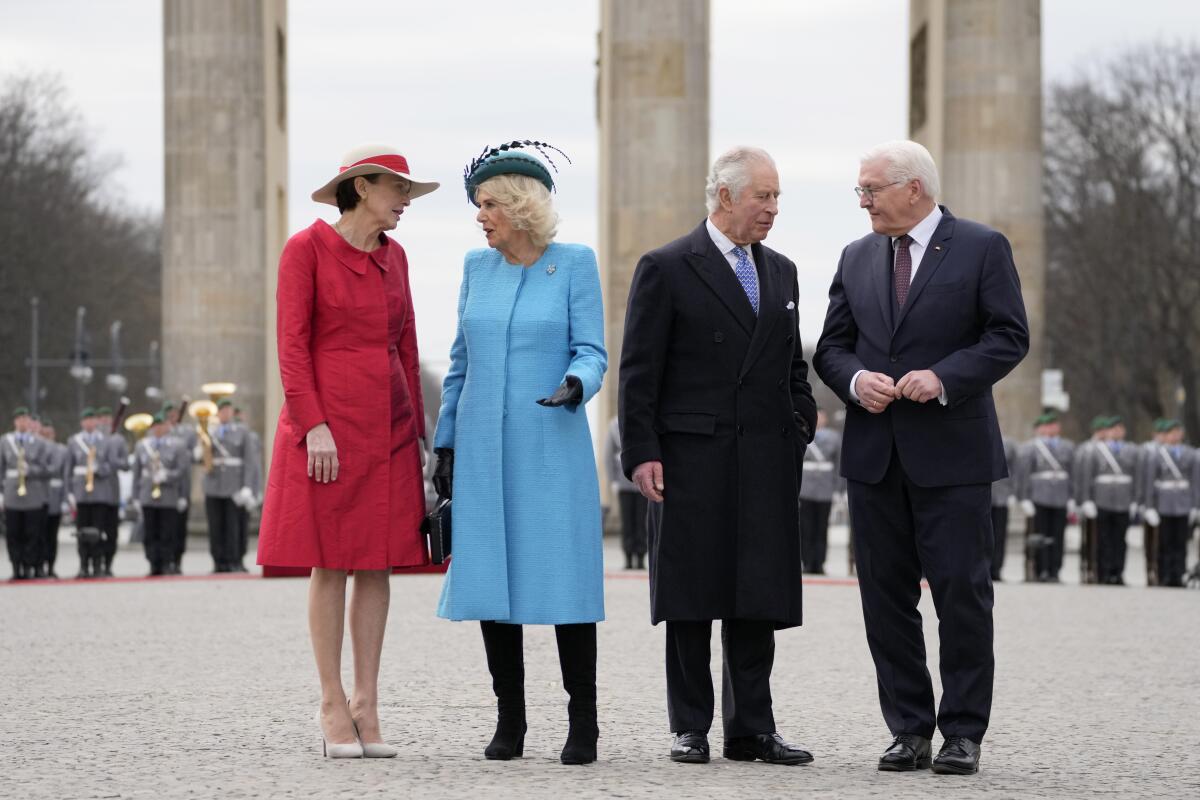
- Share via
LONDON — Britain’s King Charles III arrived in Berlin on Wednesday for his first foreign trip as monarch, hoping to improve the U.K.’s relations with the European Union and to show that he can win hearts and minds abroad, just as his mother did for seven decades.
Charles and Camilla, the queen consort, landed at Berlin’s government airport in the early afternoon. The king, dressed in a black coat, and his wife, in a light blue coat and a feather-trimmed teal hat worn at a jaunty angle, paused at the top of their plane’s stairs to receive a 21-gun salute as two military jets performed a flyover.
German President Frank-Walter Steinmeier welcomed the royal couple with military honors at the German capital’s historic Brandenburg Gate.
Charles, 74, who ascended the throne after the death of Queen Elizabeth II in September, is set to be crowned May 6. As Britain’s head of state, the king meets weekly with the prime minister and retains his mother’s role as leader of the Commonwealth.
He had initially planned to visit France first, but that leg of his trip was canceled because of massive protests there over planned pension changes.
Billed as a multi-day tour of the EU’s two biggest countries, the trip was designed to underscore British Prime Minister Rishi Sunak’s efforts to rebuild relations with the bloc after six years of arguments over Brexit and highlight the countries’ shared history as they work together to combat Russian aggression in Ukraine.
Elizabeth’s and Charles’ lives and temperaments diverged from an early age. What will his legacy be?
Billed as a multi-day tour of the European Union’s two biggest countries, the trip was designed to underscore British Prime Minister Rishi Sunak’s efforts to rebuild relations with the bloc after six years of arguments over Brexit and highlight the countries’ shared history as they work together to combat Russian aggression in Ukraine.
Now everything rests on the visit to Germany, where the king faces the first big test of whether he can be an effective conduit of the “soft power” the House of Windsor has traditionally wielded abroad, helping Britain pursue its geopolitical goals through the glitz and glamour of a 1,000-year-old monarchy.
Charles, a former naval officer and the first British monarch to earn a university degree, is expected to use more intellectual heft where his glamorous mother once wielded star power.
His visit to Germany will showcase these roles while also giving him an opportunity to highlight the causes he holds dear, such as sustainability and the environment.
Barring tragedy or revolution, Britain is set to have a man instead of a woman on the throne for the next 75 years at least.
But there will also be a full dose of the pomp and circumstance that screams royal visit, starting with the ceremonial welcome at the Brandenburg Gate, the neoclassical landmark in the center of Berlin that has provided the backdrop to so much of German history. White tie and tiaras are expected to be on display during a state dinner at Schloss Bellevue, the German president’s official residence, on Wednesday evening.
Fans of the British royals started lining up early in the morning for security checks at the Brandenburg Gate, hoping to get a close-up view of Charles and Camilla. By noon, hundreds of well-wishers awaited their arrival as police and sniffer dogs worked in the area. About 1,500 spectators were admitted to the cordoned-off area, German news agency DPA reported.
Christoph Muehlbach, 59, traveled by train from Hamburg to Berlin see the king and his wife. He described himself as a supporter of the royal family for the last 20 years and said he had traveled to London in the past for weddings, anniversaries and the queen’s state funeral.
“I take great pleasure in the British royal family,” Muehlbach told the DPA.
Prince William is seeking to prevent the backlash over his godmother’s treatment of a Black woman from undermining his trip to the United States.
Gabriele Fluechter, 57, of Berlin, said she came “out of love for England,” where she had attended university. She said she had seen Elizabeth on one of the queen’s visits to Berlin, and also had spotted Charles and Camilla before.
“They walked along there very casually,” she said, adding that the long wait Wednesday was no problem.
The king is scheduled to give a speech to the Bundestag, Germany’s Parliament, on Thursday. He will also meet Chancellor Olaf Scholz, talk to Ukrainian refugees and meet with British and Germany military personnel who are working together on joint projects. In the afternoon he will visit an organic farm outside of Berlin.
The royal couple go to Hamburg on Friday, where they will visit the Kindertransport memorial for Jewish children who fled from Germany to Britain during the Third Reich, and attend a green energy event before returning to the U.K.
Start your day right
Sign up for Essential California for the L.A. Times biggest news, features and recommendations in your inbox six days a week.
You may occasionally receive promotional content from the Los Angeles Times.
The king was urged to make the trip by Sunak, who during his first six months in office negotiated a settlement to the long-running dispute over post-Brexit trading rules for Northern Ireland and reached a deal with France to combat the people smugglers ferrying migrants across the English Channel. Sunak hopes goodwill created by a royal visit can help pave the way for progress on other issues, including Britain’s return to an EU program that funds scientific research across Europe.
The British royals are among the most recognizable people on the planet. While their formal powers are strictly limited by law and tradition, they draw attention from the media and the public partly because of the historic ceremonies and regalia that accompany them — and also because the public is fascinated by their personal lives.
Elizabeth’s influence stemmed in part from the fact that she made more than 100 state visits during her 70 years on the throne, meeting presidents and prime ministers around the world in a reign that lasted from the Cold War to the information age.
Politicians were eager to meet the monarch for tea, if for no other reason than that she’d been around so long.
More to Read
Sign up for Essential California
The most important California stories and recommendations in your inbox every morning.
You may occasionally receive promotional content from the Los Angeles Times.
